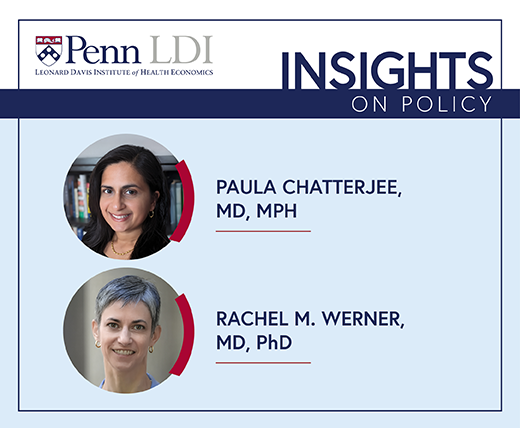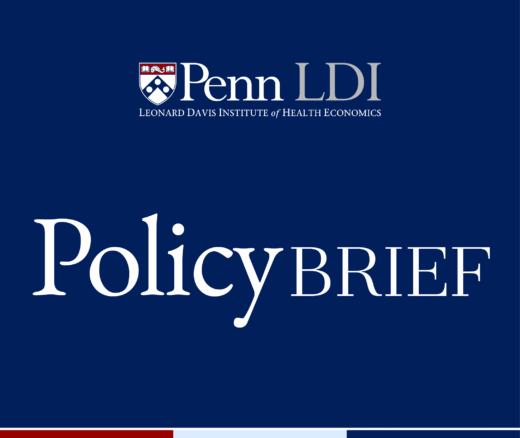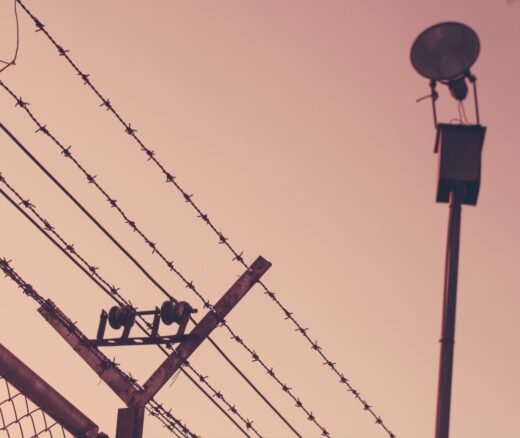
Nursing Home Incentive Program Falls Flat, New Work Explains Potential Reasons
A Major Federal Value-Based Purchasing Program Was Designed to Cut Hospital Readmissions. LDI Fellows Say the Incentives Are Too Small to Drive Real Change
News | Video
The failure to effectively target federal safety-net funding for hospitals has, for decades, lowered the quality of care and outcomes for safety-net patients, particularly for those of color. That’s according to LDI Senior Fellow and Perelman School of Medicine’s Paula Chatterjee, MD, MPH, writing in a recent JAMA Health Forum Viewpoint focused on the Medicaid Disproportionate Share Hospital (DSH) Payment Program.
Along with identifying the current problems in the DSH program, Chatterjee’s Viewpoint piece, entitled “Realigning Reality with Intent in Funding Safety-Net Hospitals,” offers four recommendations to address those problems.
Created in 1981 and revised in 2016, the DSH program was originally designed to provide funding to cover the uncompensated care provided by a subset of safety-net hospitals to large populations of low-income and uninsured patients. The intention was to ensure that such hospitals could remain financially viable and provide high-quality care to patients who were often unable pay for their care. Then, like today, many safety net hospitals would not be financially stable enough to remain in operation without the DSH funding.

Between $20 and $25 billion in combined state and federal annual funding is provided for allocation to state safety-net care facilities but, according to Chatterjee, about 30% of that total–or approximately $7.5 billion–could be better targeted to hospitals that need this type of financial support most.
“The fact that there is potentially a large degree of mistargeting in the DSH payment program means that we’re not just leaving money on the table, but we’re leaving potentially patient-improving and quality-improving money on the table. This is money that could go to tremendous, good use for a group of patients that is disproportionately at risk for bad outcomes in the first place,” said Chatterjee in an LDI interview.
“We know that when Medicaid DSH payments get to the hospitals that they’re designed to reach, that funding is associated with better inpatient outcomes. Things like inpatient mortality from heart attack and neonatal mortality improve. We’re not just talking about money in the health care system in an abstract sense. What we do know is that when DSH money is targeted effectively, patients benefit in really meaningful ways that are salient to their hospital care.”
Some of the ways in which the mistargeting of DSH payments manifests can fall heavily on vulnerable communities of patients.
“Some of our prior work shows that the way we currently allocate Medicaid DSH payments might be subject to structural racism biases,” said Chatterjee. She explained that a county-level analysis has shown that disproportionately large Black populations have much higher health needs but do not receive DSH payments commensurate with those higher levels of need.” In fact, she said, they receive payments that are quite a bit lower.
Another finding was that about 32% of hospitals that receive DSH funds actually lack the levels of uncompensated care required to make them technically ineligible to receive DSH funds.
“This suggests that there’s a real opportunity for us to change the way that we think about targeting these DSH payments so that they reach the counties and communities that could benefit from them most,” said Chatterjee. “Revisiting the design and implementation of the DSH program thus represents a key policy lever for improving health equity in the US by improving support for the hospitals and health systems that serve low-income communities.”
However, she pointed out, “The allocation of Medicaid payments across the country operates under a pretty complicated political economy and the way payments were allocated in the 1990s is largely how they are still being allocated today. This, despite the remarkable changes that have occurred in insurance [coverage] and the distribution of poverty in the U.S. since then. Part of the challenge is that it’s very hard to take money away from hospitals that were traditionally receiving it, and policymakers and legislators are often very protective of the payments that they have historically received. Changing that has proven to be a pretty formidable challenge.”
Chatterjee’s recommendations for realigning DSH payments with the original intention of the program were these:


A Major Federal Value-Based Purchasing Program Was Designed to Cut Hospital Readmissions. LDI Fellows Say the Incentives Are Too Small to Drive Real Change

Penn LDI’s Antonia Villarruel and 10 Other Authors Map Social Determinants Across Multiple Racial and Ethnic Groups

Memo: Response to Request for Analysis

Lessons from the Past, Imperatives for the Future

An LDI Expert Offers Five Cost Control Measures As Congress Continues Its Affordability Debate

A New Study of a Sample of Facilities Found Half Without Any Behavioral Health Staff